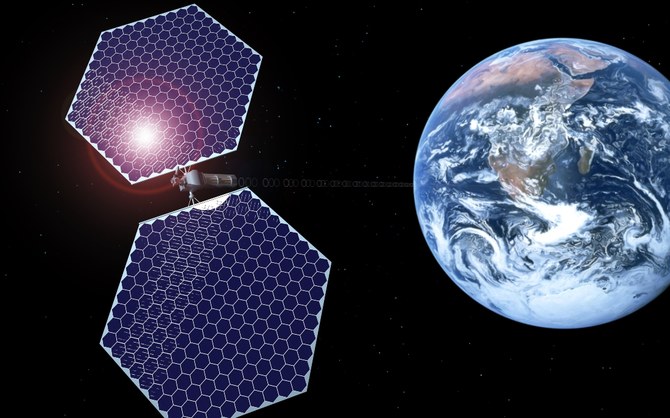
- ARAB NEWS
- 15 Jul 2025

The concept of harnessing solar energy from space has transitioned from the realms of science fiction to almost tangible reality, with advancements in technology bringing us closer to tapping into the vast power of the sun. And the Gulf Cooperation Council countries have a unique opportunity to be at the core of this potential new method of power distribution. Saudi Arabia, the UAE and Oman have already set out ambitious plans for the future of space.
This is a perfect and historic opportunity to continue being leaders in the energy sector and, more importantly, the future of renewable energy, while also becoming leaders in the commercialization of space. Although telecommunications have so far always been the core of the space economy, this is a development that fits the long-term goals of the GCC.
We need to be a little technical to better understand. There are two primary methods proposed for this endeavor: space-based solar power and direct sun reflection.
This is a perfect and historic opportunity for the GCC states to become leaders in the commercialization of space
Khaled Abou Zahr
Space-based solar power involves the collection of solar energy by satellites in geostationary orbit that are equipped with photovoltaic panels. These satellites would harness the energy from sunlight and wirelessly transmit it to Earth via microwaves or laser beams. A constant exposure to sunlight, unimpeded by the Earth’s atmosphere or the day-night cycle, would allow for an uninterrupted energy supply.
The key challenges for this method are the cost-effective launch and maintenance of the solar satellites and the development of safe and efficient energy transmission systems. Advancements in photovoltaic technologies and the development of self-assembling satellites are enhancements that improve the efficiency and feasibility of space-based solar power systems.
In contrast, direct sun reflection is a concept that involves the use of a constellation of mirrors in space to reflect sunlight directly onto solar farms on Earth. This method aims to increase the amount of solar energy captured by these farms without the need for additional infrastructure. The mirrors can be placed in low Earth orbit and be capable of reflecting sunlight to extend the productive hours of solar farms, potentially adding up to two extra hours of peak sunlight per day. This could lead to a significant increase in energy production — as much as 60 percent annually. The idea is that, by focusing additional sunlight onto solar panels on the Earth’s surface, the overall efficiency and output of solar farms can be greatly enhanced.
This method was first experimented with by Russia through its Znamya project in the 1990s. Znamya aimed to demonstrate the feasibility of illuminating various points on Earth by reflecting sunlight from space using mirrors. Znamya 2, a 20-meter reflector launched in 1992, successfully illuminated a 5 km-wide area with a brightness matching that of a full moon, despite limited visibility due to clouds. Its successor, Znamya 2.5, attempted to create a 7 km-wide luminous spot in 1999, but it failed when the mirror tore on an antenna. The ambitious Znamya 3, envisioned to be 60 to 70 meters wide, was never realized after the preceding experiment’s failure.
Despite its challenges, the Znamya project stands out as a pioneering effort in space-based solar reflection to Earth. However, the project was discontinued due to technical difficulties in controlling the reflected light and concerns about the environmental impact of such intense beams on Earth’s ecosystems and human health.
With space-based solar power systems, a single satellite could generate about 2 gigawatts of power, which is comparable to a conventional nuclear power station and sufficient to power more than 1 million homes. The energy density at the center of the beam from such a system is expected to be about 250 watts per sq. meter.
With space-based solar power systems, a single satellite could generate about 2 gigawatts of power
Khaled Abou Zahr
Those competing in the space-based solar power field include major aerospace and technology companies such as Airbus, Northrop Grumman, OHB SE, Thales Alenia Space and Boeing. Additionally, initiatives like the UK’s Space Energy Initiative aim to bring together government, research and industry to develop space-based solar power.
The leading consortium for direct sun reflection, as part of the European Space Agency’s SOLARIS initiative, includes Arthur D. Little, Engie, Air Liquide, Thales and Dassault Aviation. It proposes that a constellation of 4,000 mirrors could significantly boost green electricity and green hydrogen production, while saving 8,500 megatons of carbon dioxide emissions over 30 years.
Although they have similar goals, the differences between the two methods are significant. As we often say, space is hard. This is why, on this specific topic and not knowing today which solution will offer the best outcome, GCC countries should join forces in the ambitious goal of harnessing energy from space. There is a poetic turnout, which is that the region is capable of leading with energy from below the ground and above the atmosphere. It is also a natural evolution, not only because of the vast amount of sunshine falling on the Arabian Desert, but also because GCC countries are the core of today’s energy supply chain, whether physically or in terms of financial flows.
As we look to the future, the potential for space contributing to a clean and inexhaustible energy source is immense. It could play a crucial role in meeting the growing global energy demand, while also addressing climate change concerns. It is the perfect challenge for GCC countries to unite and meet together, as the advancements in space technology and material science may soon allow us to overcome the current barriers, making space-based solar power a critical component of our energy mix.
As we continue to innovate, the once-distant dream of harnessing solar energy from space is moving closer — and the GCC states should help make sure it becomes a reality.